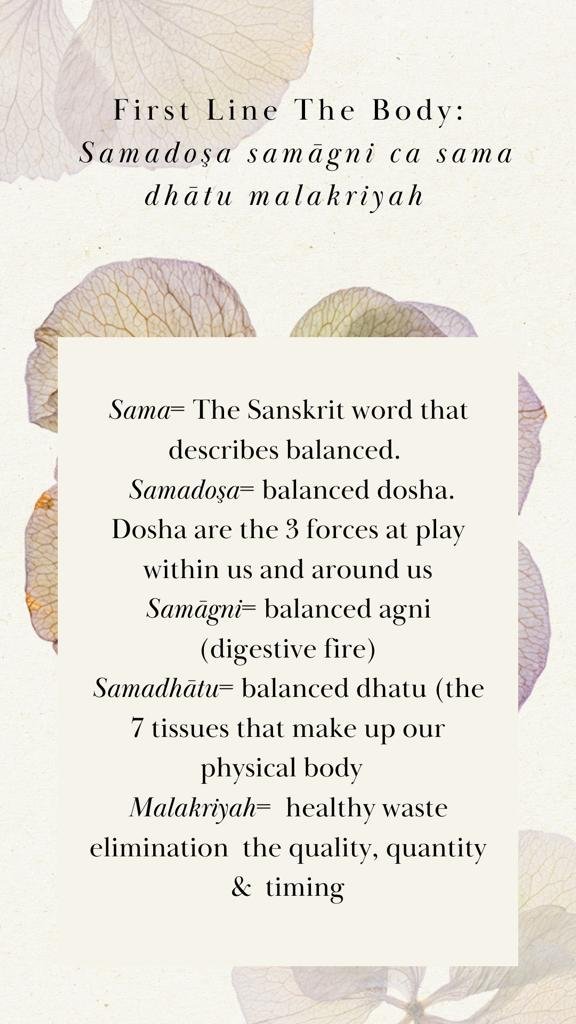Before I got into Ayurveda I was practising Ashtanga yoga, which is famously known as being “designed for young boys, by men”
On my visits to India and in my early study of yoga and vedic philosophy I didn’t come across any information or guidance addressing life in a woman’s body. Not until I traveled down the path of studying ayurveda with a woman doctor, did the realm of women’s wellbeing and feminine spirituality open up.
Although many of the old textbooks on Ayurveda are dense, rigid and dry - the essence of Ayurveda is juicy, life affirming and ever evolving. She teaches us how to speak our mother tongue, the language of mother nature, she revives the mother consciousness that is within us all.
The definition of health
Ayurveda is nature based system and as we observe the current state of the world we see that our progressive imbalance with the maternal energies of nature is the primary cause for violence and disease. Health is not just the absence of disease but our capacity to evolve as we are part of the ecosystem of life.
The definition of health, in Ayurveda is “Swasrha” this sanskrit word can be understood to describe a dynamic state of wellbeing and vitality and literally breaks down to “Swa” meaning oneself and “stha” meaning to be situated.
To be situated in oneself.
As women, we have the great power of Shakti primordial feminine energy - not only to heal ourselves, but to nourish, nurture and heal everything around us. There are specific times throughout the year where we become vulnerable to imbalance, that can progress into disease - especially when we are not living in harmony with nature’s seasons. in the same way, when we are living in dissonance with our menstrual cycle, our inner seasons, imbalance and disease is likely to set in.
One of the aspects of Ayurveda that I love is that the WHOLE woman is considered; her body, mind, creativity, cyclical nature and soul. Let’s get into the specifics.
Ayurveda & the Menstrual cycle
4 Signs of a healthy cycle
Timing is monthly and regular
Your blood flows for 5 nights
Colour is bright and lively
No pain discomfort
Sign of Vata effected menstruation
Cycle is irregular and painful, scanty flow
Sign of Pitta effected menstruation
May experience a short cycle (early period) heavy flow and tenser breasts
Sign of Kapha effected menstruation
Long cycles (late period) weight gain & exhaustion around period, clotty blood and in extreme cases of imbalance where women experience chronic pain, burning sensations, fainting or blood flow for 7+ days we look more deeply into the symptoms and uncover where the dosha imbalance lies. On the other hand, some women ‘lose’ their periods - a condition known as Amenorrhea
“Missing” menstruation
Common causes of amenorrhea
Family history of amenorrhea or early menopause.
Genetic or chromosomal condition that affects your menstrual cycle. Obesity or being underweight.
Eating disorder. Over-exercising. Poor diet. Stress.
Chronic illness.
Pituitary disorder Hypothyroidism
Endometriosis
In Ayurveda Endo is considered a Kapha dosha problem due to the build up of cells. It can also be thought of as a Pitta dosha issue due to the involvement of blood, tissue and inflammation, as always it depends on what’s going on with the woman as a whole, there is much to consider beyond what is going on directly in the womb.
Common signs and symptoms of endometriosis
Painful periods (dysmenorrhea). Pelvic pain and cramping may begin before and extend several days into a menstrual period. You may also have lower back and abdominal pain.
Pain with intercourse. Pain during or after sex is common with endometriosis.
Pain with bowel movements or urination. You're most likely to experience these symptoms during a menstrual period. Excessive bleeding. You may experience occasional heavy menstrual periods or bleeding between periods (intermenstrual bleeding).Infertility. Sometimes, endometriosis is first diagnosed in those seeking treatment for infertility.
You may experience fatigue, diarrhea, constipation, bloating or nausea, especially during menstrual periods.
Breast Care
In Ayurveda there are 7 types of tissues (ghatus) that makes up the human body. Our breast tissues is comprised of two chats, rasa (which is the lymphatic fluids) and media thatu which is the fatty tissue. There are some important practises that should be used to maintain breast health.
Self massage, using warm sesame oil gently massage the breast in circular motion moving toward the heart
regular detox, gentle detoxification should happen on a daily basis through proper diet and elimination but a deliberate seasonal cleanse is very supportive for the lymphatic system.
Yoga, pranayama and meditation are all fantastic for the breast tiissue
Hydration; sip water slowly through the day, adding fresh ginger is very beneficial for balancing doshas also.
I have another blog post in the making all about Yoni Care, check out the feed !




